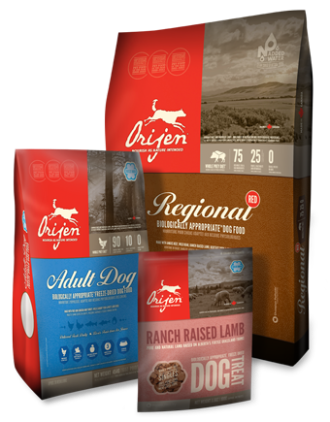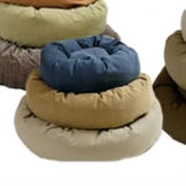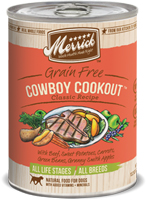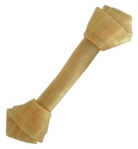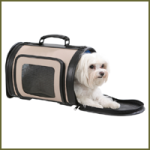In this blog post, we’re going to talk about pet food. We’ll try to demystify it a bit, and let you know which dog and cat foods are our favorites.
First, gone are the days of feeding your dog or cats just anything off the shelf. As pet owners, not only are we concerned about what we put in our own bodies, but we’re also concerned about what goes inside our pet’s bodies. Garbage in, garbage out. Also, you may have not noticed, but pets are living longer now, due in large part to the good nutrition they’ve been getting from great quality pet foods.
So let’s start with what’s not good for your pet. In our opinion, and based on our research and anecdotal evidence, we feel that dogs and cats don’t really need grain in their diet. Grain is placed in pet food as a filler so that your pet can feel fuller when they eat, plus it also lowers the cost of the food. Many dogs and cats are allergic to grain and the allergies can manifest themselves as bad skin problems like itchy skin, hot spots, rashes, licking on their paws, irritable bowels, among other things. Grain can include anything from corn and wheat, to soy, to rice, to oats and so forth. That’s not to say that all food that contain grains are bad for your pet. We carry a few brands that do contain grain, but we make sure the grain is balanced with good proteins and vegetable content to give your pet a well rounded diet.
We also don’t really like anything that contains by-products in the ingredients panel. In it’s simplest form, by-products are anything left after an animal has been slaughtered that is not really meant for consumption. If you’d like to know more about by-products, do a Google search and you’ll learn more than you ever want to know. So if possible, try to avoid at least by-products in any of the food you purchase for your pet.
What type of pet food do we like? We like the type of food that mimics the ancestral diet that your dog and cat would have fed on in the wild before they were domesticated. This means meat proteins and vegetables, with some fruit thrown in. The new movement in pet food follows this path. Nowadays, there are many dog and cat food options which mimic their ancestral diets including, grain-free kibble, can foods, raw foods, freeze dried food, and so on. Here at Best in Show, we like grain-free kibble and raw diets. Our most popular grain-free kibble brands are Orijen and Acana. It’s not a coincidence that they’re made by the same parent company. We like these brands because they source all of their ingredients from farms local to their processing plants in Canada. There are no foreign sources of ingredients in any of their foods. They have a very symbiotic relationship with local farmers and and with their immediate community. Orijen is a high protein dog food and Acana is a moderate protein dog food. Stop in to see us to find out what the difference between high and moderate protein is about.
We also like raw frozen foods. These are foods that have not been cooked but are left in their natural, raw state, except for being frozen to guard against spoilage. You feed these types of foods by thawing and serving, not cooking. Raw food is the closest to an ancestral diet as you can get. Most contain only meat protein and vegetables along with some vitamins and minerals and other supplements like omega fatty acids which is great for a healthy skin and coat. We carry the Small Batch brand and Instinct brand of raw, frozen food. If you want a to feed food that is the closest to an ancestral diet, feed raw.
So to recap, look for grain-free kibble if you’re feeding your pets a dry food. If you don’t want grain free, make sure the brand you’re purchasing is a well rounded meal of grain, protein and fruits and vegetables. And, make sure your food has no by-products in it. Raw food is the closest you’ll get to an ancestral diet if your pet will eat it. The texture is obviously different from kibble or canned foods, but it’s a great alternative diet.
Also, rotate your pet’s diet as much as is practical. By switching proteins and brands and types of food, like dry, canned and raw, this helps your pets develop a more robust system which in the long run will make them healthier and live a longer life. Because after all, for all the joy they bring us, we want them to be with us as long as possible. Come and see us and we’ll tell you about pet food. 545 Castro Street, between 18th and 19th.
Demystifying Pet Food
Posted in Uncategorized with tags Acana, Best in Show, castro pet shop, cat food demystified, dog food demystified, grain free cat food, grain free dog food, Instinct dog food, Orijen, raw cat food, raw dog food, Small Batch dog food, what do I feed my cat, what do I feed my dog on May 20, 2014 by Lucky DogPet Beds…the reasons why your pet needs one
Posted in Uncategorized with tags bagel bed, bed with built up sides for cat, bed with built up sides for dog, Best in Show, bolster cat bed, bolster dog bed, castro cat boutique, castro cat store, castro dog boutique, castro dog store, castro pet boutique, castro pet store, cat bed, comfortable bed for cat, comfortable bed for dog, dog bed, orthopedic cat bed, orthopedic dog bed, pet bed on April 14, 2014 by Lucky DogWhy does your pet need a bed? After all, don’t they just sleep with you? Or on the floor? Or on the couch? In this post, we’re going to discuss the benefits of getting your pet their own bed, and then we’ll tell you about our favorite pet bed.
So, why does your pet need their own bed. They need their own bed for several reasons.
- First, so they have a place to go when they want to sleep. It’s like you wanting to go to your own bedroom when you’re tired and want some zzzzz’s.
- Second, pets need their own space to hang out when they’re tired after a long day at the dog park or when they need a time-out.
- Third, its a great place for them to cuddle with their toys or chew on their favorite bone.
- Fourth, pets need their own space. Plain and simple. It makes them feel comfortable and secure when there’s a place or a space (or in our case a bed) that they can go to whenever they want to escape from it all.
Our favorite pet beds are the Bagel Beds shown in the photo above. It’s the only bed we carry in our store and is made locally in the San Francisco Bay Area. Why is it our favorite bed?
- Because it has a double thickness of orthopedic foam on the floor of the bed, which will provide your pet with extra support and comfort. The orthopedic foam never breaks down or mats down. Some beds are made with just a fiberfill center mattress, and after a while, the fiberfill mats down so your pet really ends up sleeping on the floor instead of something comfortable.
- Because there is a thick, extra-padded bolster that goes all the way around the bed (hence it’s bagel shape). You know that comfortable, secure feeling your pet gets when they lean up against you? That’s what the built-up side bolsters provide. Comfort and security.
- Because the covers unzip and are machine washable and dry-able. This ensures that your pet’s bed is clean whenever it needs to be cleaned. And the covers wash beautifully, especially the micro-fiber fabric ones, which are our favorites.
- Because it comes in a variety of colors and fabrics that will complement any decor. We’re only able to carry a select number of beds in our store because of space constraints, but you are not constrained by your imagination. We have a fabric ring of over 50 fabric and color swatches for you to choose from. Don’t see what works for you in our store? Ask, and we’ll special order the color and fabric you want at no extra charge, from our ring of fabric swatches. Typical turnaround time is 7 – 10 working days. Fast, right?
So now you know why your pet needs a bed of their own. Stop in to see one of our associates at our brick and mortar store for more information. Best in Show, 545 Castro Street (between 18th and 19th), 415-864-7387, info@bestinshowsf.com, #bestinshowcastro.
Canned dog foods offer nutritional benefits for many liefstyle needs
Posted in Uncategorized on May 11, 2013 by Lucky DogEvery dog is different when it comes to dietary needs, and the nutrition from canned foods may provide many benefits for a variety of lifestyle requirements and overall well-being. In addition to feeding wet foods for variety and health benefits, pet owners are also looking for foods that look more like something they would eat, rather than something a dog might consume. A national survey of pet owners found that 40% of dog owners preferred gourmet canned food, while 22% used premium canned food. This same survey also showed that canned foods are primarily purchased (40% of canned foods; 25% of dry foods) when pet owners are looking for specialty or “upscale” foods for their pets. Stop by our store to see our wide array of natural and gourmet recipes that feature whole or shredded ingredients in gravy or broth, and pate styles that contain ingredients that are recognizable to most pet owners.
National Adopt a Shelter Dog Month – October
Posted in Uncategorized with tags adoption, Best in Show, best in show san francisco, castro pet boutique, national adopt a shelter dog month on October 6, 2010 by Lucky DogHow Old Are the Members of My Family?
If the youngsters in your household are under seven years old, they are usually not developmentally suited for puppies 5 months old and under or toy-sized (under 15 pounds) dogs of any age. Puppies have ultra sharp “milk teeth” and toenails and often teethe on and scratch children, resulting in unintentional injury to the child. The puppy can become something to be feared rather than loved.
Toy dogs are fine-boned, touch-sensitive creatures that do not weather rough or clumsy handling well. They break relatively easily and are quicker to bite than their larger boned, mellower relatives.
Unless your children are unusually sensitive, low-key, respectful individuals, a medium-to-large sized dog over 5 months old is usually the safer choice. Regardless of size, all interactions between small children and dogs should be monitored by a responsible adult. When there is no one to watch over them, they should be separated.
Who Will Be the Dog’s Primary Caretaker?
Some parents bow to the pressure their children put on them to get a dog. The kids promise with tears in their eyes that they will religiously take care of this soon-to-be best friend. The truth of the matter is, during the 10 – 15 year lifespan of the average dog, your children will be growing in and out of various life stages and the family dog’s importance in their lives will wax and wain like the Moon. You cannot saddle a child with total responsibility for the family dog and threaten to get rid of it if the child is not providing that care. It is not fair to child or dog.
Choosing the family dog should include input from all family members with the cooler-headed, more experienced family members’ opinions carrying a bit more weight. The family dog should not be a gift from one family member to all the others. The selection experience is one the entire family can share.
Do I Have the Financial Resources to Care for My Pet?
The purchase price of a dog is a very small part of what the dog will actually cost – many soon to be owners forget the necessary expenses such as veterinary care, food and treats, a training crate, obedience classes and grooming.
And then, there is the veterinary emergency! Very few dogs live their entire lives without at least one accident. Your puppy eats a battery or pair of pantyhose, your fine-boned toy breaks a leg, your big boy has bad hips, your dog gets hit by a car or beaten/bitten by the neighborhood bully. These surprises can cost $500 or more.
How much time and energy can you spend on a new dog? Various breeds and ages of dog make different demands on our precious spare time. In general, the Sporting, Hounds, Herding, and Terrier breeds will demand more time in training and daily exercise than will the Guardian or Companion breeds. A puppy or adolescent will need more exercise, training, and supervision than will an adult dog. And the first year with any new dog regardless of age or breed type will put more demands on the owner than any other time, for this is when you are setting up house rules and routines which will last for the lifetime of your dog.
How to Potty Train and Housebreak your Dog
Posted in Uncategorized on September 29, 2010 by Lucky DogThere is so much joy when you bring a new dog home for the first time and potty accidents comes with the territory of pet ownership. A puppy isn’t born knowing that your carpet or hardwood floors is not an acceptable place to relieve himself. So be sensitive to this learning curve and remember that accidents happen.
Even the best dogs have their share of oops! House training your dog and staying tuned in to their potty break signals will make sure your dog gets outdoors quickly, not giving him enough time to soil your hardwood floors. Establishing a potty training routine is the first step toward a happier life with your new found furry family member. Here are some tips on house training your dog:
1. Take your dog out at the same time each day. Suggestion would be in the morning when he wakes up before breakfast, upon arrival from work, and before bed time.
2. Praise, Praise!! Dogs will do anything for a reward and to hear you say “Good Girl” or “Good Boy”. After she potty outside immediately praise, so she knows why she is getting praised. Don’t wait until you get back inside to do so because she won’t remember why she is getting praised. She will soon learn that going to the bathroom outside equals treat & praise.
3. Location, Location- Choose a spot outside that will be your dogs official porter potty area (make sure the area is cleaned daily). Dogs like the security & familiarity, picking one specific spot will make her feel at ease and help to know that area of the yard equals. Your dog will need supervision so take her on leash to the potty spot. The best part about picking a spot is that you won’t have the problem of landmines all over the yard and a small area to clean.
4. Choose Your Words Wisely- Giving your dog a command to “go potty” or “do your business” will let her know what is expected of her. While your dog is going to the bathroom outside use words or phrases like “go potty” that they will come to understand. As time goes on when you say the words “go potty” she will immediately run to the door instead of relieving herself on your floor and run back inside afterward.
5. Schedule Feeding- Like humans, dogs like eating on a regular schedule and this will make them more regular in the literal sense.
6. Don’t Rush Potty Time – Give her about 10 minutes to go potty, if she does not do so bring her back in and take back out in 15-20 minutes for another try. She should not be able to run or play inside until she has went potty, play is her reward for being on good potty behavior.
If you catch your dog eliminating in the house, do something to interrupt her but make sure not to scare her. Immediately take her outside to her bathroom spot, afterward lavish her with praise & treat for job well done.
Keep in mind that potty training any dog requires repetition and hands on approach. Be fair warned no dog is perfect and their will be messy moments throughout the process . But as time goes on she will learn that bathroom time is outside. If you happen to sniff and find a soiled area in your house hours or days later it is too late to administer a correction. Do nothing but clean it up. Rubbing your dog’s nose in it, taking her to the spot and scolding her will not help the situation. In fact it will make her more afraid of you and even more afraid to potty in your presence. Animals do not understand why they are being punishment once time has passed and scolding can do more harm than good.
Now on to the fun part, clean up. Cleaning up the the soiled area in your home is very important because dogs are highly motivated to continue soiling in areas that smell like urine or feces. So keep it squeaky clean & green with eco-friendly, all natural, non toxic cleaning products. Pet Oder & Stain Remover like Petastic Stain and Odor Remover are safe.
Happy potty training!!
To Rawhide or Not To Rawhide
Posted in Uncategorized with tags Best in Show, best in show san francisco, bony babies, castro pet boutique, compressed rawhide chew bones, rawhide chew bones on August 25, 2010 by Lucky DogRawhide is typically made from cowhide. It is the inner layer of hide. There are two types of rawhide on the market, both of which we carry. The first is a traditional white knotted-bone rawhide, which you’re probably most familiar with. And the second type is a compressed rawhide. The difference between compressed and regular rawhide is that the compressed rawhides are first broken down into smaller pieces. Then, several layers are pressed back together in various shapes and forms. You get multi-layers of rawhide with the compressed version, which also tends to make this last longer than the traditional rawhide chew. The hide on the compressed rawhide bones look almost translucent, or see-through. Our Bony Babies toys have a compressed rawhide chew-bone sewn right inside, so you get both a toy and a treat together in one item. Both types of rawhide, traditional and compressed, are safe, but we always advise parents to supervise your dog when they are chewing on anything.
There are many benefits to giving your dogs rawhide treats, including dental health. As your dog chews, the rawhide aids in scraping plaque and tartar off their teeth. Rawhides also have great behavioral benefits. Dogs instinctively like to chew, especially puppies. But instead of your new shoes or furniture becoming your dog’s favorite, you can offer rawhides to deter them from your precious items.
Whichever version of rawhide you pick for your pup, we recommend doing your research first. Ask questions, and then decide. Until next time…WOOF!
Clipping Nails and Brushing Teeth
Posted in Uncategorized with tags brushing cats teeth, brushing dogs teeth, cat grooming, cat nail clippers, cat nail clipping, cat toothbrush, dog grooming, dog nail clippers, dog nail clipping, dog toothbrush on August 14, 2010 by Lucky DogFirst, give them loads of affection so they associate grooming time as a happy time. Make sure that it’s a happy setting and that you are constantly rewarding and showering them with affection and words of encouragement. If you have a food motivated pet, make sure to use treats so that they start associating grooming time with being rewarded. For cats, we suggest our top selling Bonito Flakes, and for dogs you could use our Soft Training Treats.
After you’ve mastered bath time with our Pal Dog and Pal Kitty Shampoo and Conditioners, it’s time to take on dental health, and maintenance of your pet’s nails. We meet pet owners daily who have never brushed their pet’s teeth or clipped their nails, until they visit us for advice and suggestions. We understand that these tasks can feel daunting and scary, and the most common excuse we hear for not doing these things is that your pet will not allow it. Similar to training and bathing, it’s all about consistency and gradually introducing new things into your pet’s life. Below, we’ve listed a daily schedule of exercises that we’re sure will make clipping your kids nails and brushing their teeth as simple as handing them a treat.
Teeth Brushing:
Day One – Place your pet on your lap. If you have a larger pet, you can sit on the floor with them on your lap. Place a small amount of pet toothpaste on your finger and allow your pet to lick it off, so they become familiar with the taste. We have enzymatic toothpaste which comes in many flavors, including malt and peanut butter.
Day Two – Repeat Day one, but this time, get your finger as close to their teeth as possible. This will help them acclimate to having a toothbrush in their mouth. As with all grooming exercises, make it a happy time.
Day Three and Four – Place a small amount of the toothpaste on a pet toothbrush and let your pet get used to the feeling of the bristles on the brush. On the fourth day, try to get the toothbrush into their mouth and even towards the back of their mouth.
Day Five – Once they’ve become familiar with the taste of the toothpaste, and the feeling and texture of the toothbrush, you can start to brush their teeth softly, making sure to get the back teeth. Continue this exercise until your pet is comfortable with the brush in their mouth. It is recommended that you brush your pet’s teeth at least twice a week to maintain optimal dental care.
Trimming Nails
We have so many customers come into Best in Show who have never trimmed their pet’s nails, but want to start doing so. Below are a few steps and suggestions on nail clipping. Throw in some patience, and you’ll make trimming nails an easy task to add to your grooming repertoire.
Day One, Two and Three – Get your pet accustomed to having their paws handled. As with any grooming exercise, you’ll need to reward them with affection, words of encouragement, and possibly treats. Remember to make this a happy experience.
Day Four – You can introduce the nail clippers on this day. We carry the traditional clippers and the guillotine nail clippers. Start with petting their paws. Let them see the clippers and while you’re petting their pads, touch the clippers to each nail. Repeat this as many times as necessary, but don’t do any clipping on this day.
Day Five– Today’s the day to make the cut…literally. Don’t be timid or scared as your pet will pick up on that. Approach the task with confidence and a happy demeanor. If you’re unsure about how much to clip off, just clip a tiny bit at a time. With most nails, you can see the quick, or the vein that juts into the nail. Don’t cut that or your pet will start bleeding. Make small cuts, and if you’re unsure, don’t cut any more.
So there you have it. A clean, well groomed pet makes for a happy pet owner! Not only does brushing your pet’s teeth, clipping their nails, bathing and brushing their coats make for a healthy pet, but it also strengthens the bond between pet and master. Our pets offer unconditional love and want nothing more than to please us. Rewarding them with a healthy life is the least we can do.
Keeping Your Dog Occupied When the Weather Doesn’t Permit Going Outside
Posted in Uncategorized with tags alleviating boredom for dogs, Best in Show, best in show san francisco, castro pet boutique, Treat dispensing toys for dogs on August 3, 2010 by Lucky DogTreat-dispensing toys: Let’s face it, most dogs are food motivated, and great way to motivate these dogs is with one of our treat-dispensing toys. There’s the granddaddy of them all, the Kong. This funny shaped rubber toy is meant to be filled with the accompanying Kong Stuff’n, then placed in the freezer, and given to your pooch when frozen. Freezing the toy with the treat inside will prolong the pleasure and the cold temperature will allow them to cool off from the heat outside. We also carry the Busy Buddy line of treat dispensing toys, which includes the Tug-a-Jug. This treat-dispensing toy will definitely stimulate your dog and give their brain a workout.
Indoor Fetch: No matter what size your house or apartment is, we’re sure that you can make enough room to play a game of fetch with your furry pal. You might want to save the Chuck-It for a more open space, but for those kids who want nothing more than a game of fetch, try our Bumi toy. Not only is this brand of toys “guaranteed to last”, the Bumi can also be used as a tug toy between you and your pup. If your dog is gaga over balls, we’d suggest a ball with grooves or uneven surfaces for indoor play. Our Huck is the perfect ball for indoor play. Toss it down the hall and watch as it bounces erratically and keeps your dog on his toes…or should we say paws?
Brush up on sit and stay: A day indoors for your dog usually means catching up on sleep. If only we had it so good. Although, it’s been suggested that an inactive dog is a destructive dog, the perfect remedy to keeping those behaviors at bay is continuing education. Your buddy wants nothing more than to please you, and you can help them do this by teaching them new tricks and commands. Don’t forget to have a handful of a treats like our Liver Chips as a reward for their learning.
We’ve all experienced days where you don’t want to go outside. The rain just won’t let up, the snow is falling or it’s simply so hot outside that your shoes melt on the pavement. Take time out on those days and make sure you tell your pups that you love them and carve out enough time for play. Just think about the rewards afterward…unconditional love.
Preparing Your Pet for Airline Travel this Summer
Posted in Uncategorized with tags airline pet carrier, Best in Show, best in show san francisco, castro pet boutique, dog airline travel, pet travel on July 30, 2010 by Lucky DogYou should first familiarize yourself with the airlines pet policies and take note of the following:
· Does the airline allow pets in the main cabin?
· If the cabin is not an option, do they have restrictions on transporting your pet below the cabin?
· Does the airline have any pet health and immunization requirements?
Before the actual trip, we’d advise visiting your vet to ensure that your pet is okay to travel, and it’s up-to-date on all vaccinations. During your pre-trip vet visit, you can also ask your vet to issue a certificate of good health, which may be necessary at different points during your travels.
All airlines require that pets traveling in the cabin of a plane must be stowed in a carrier that zips completely closed. You can check out Best in Show’s airline carriers here. We recommended that you introduce a carrier to your pet as far in advance of your date of travel as possible. This will help acclimate them to the carrier, and lessen the stress of travel. There are many ways you can make your pet feel comfortable in their carrier. One way is to motivate them with treats. Reward them each time they venture into and out of their carrier. Surround them with familiar items such as their favorite toys or a blanket.
When booking your flight, consider non-peak flying times. This will help lessen the stress of travel, in addition to providing you and your pet with a bit more leg room. Also consider, whenever possible, booking direct flight versus layovers, because some layovers may not offer the chance for a potty break, or may break your pet’s calm mood.
You might also want to make sure that all of your pet’s ID tags are up-to-date. And bring along an extra leash and collar set, just in case. As soon as you land, find a quiet area to let your furry pal out, and offer them love and treats for being such great travelers.
Safe travels this summer. Check out all of the great items we carry for travelling with your pet here. We’re certain that your child will thank you for taking such great care of them.
